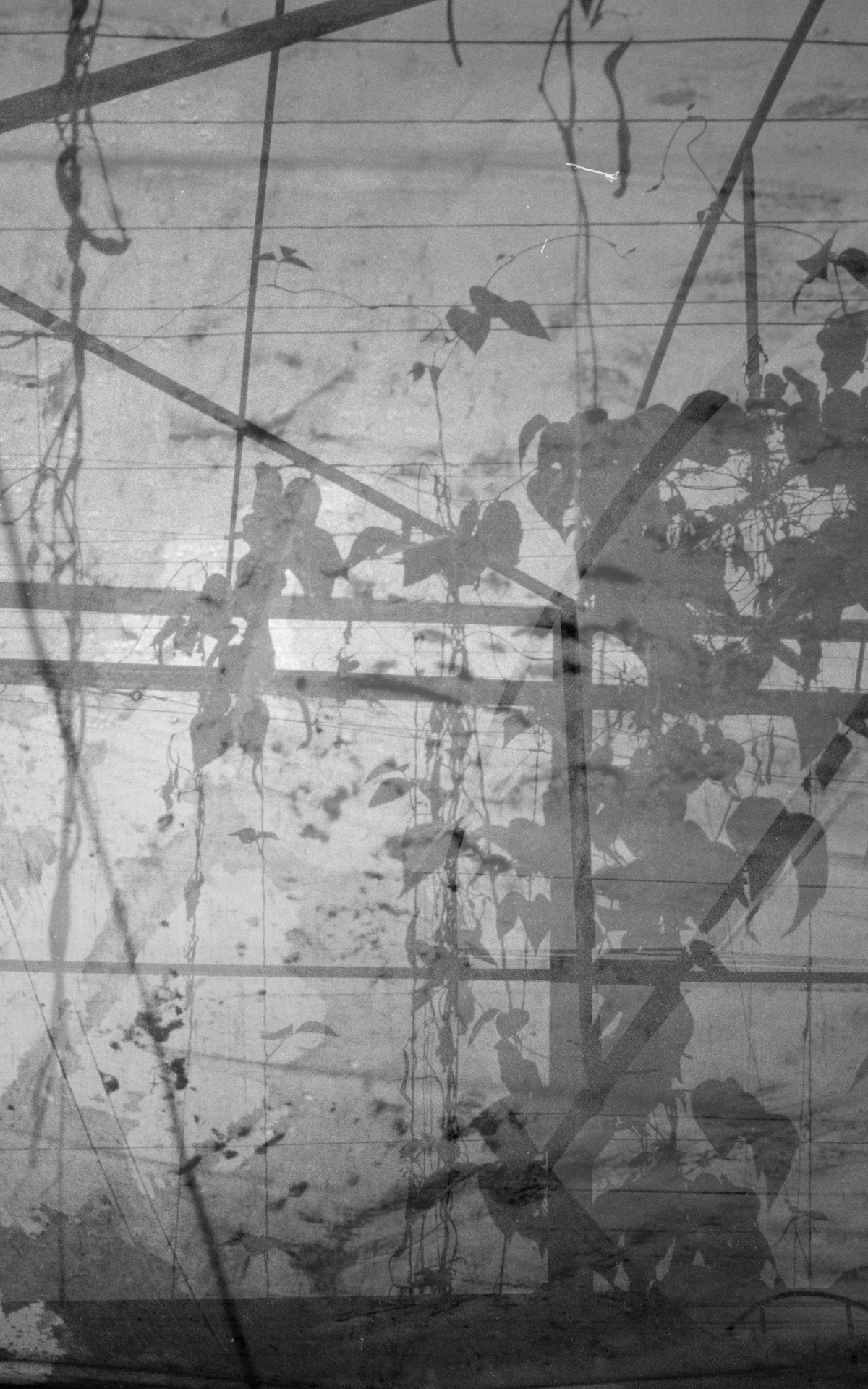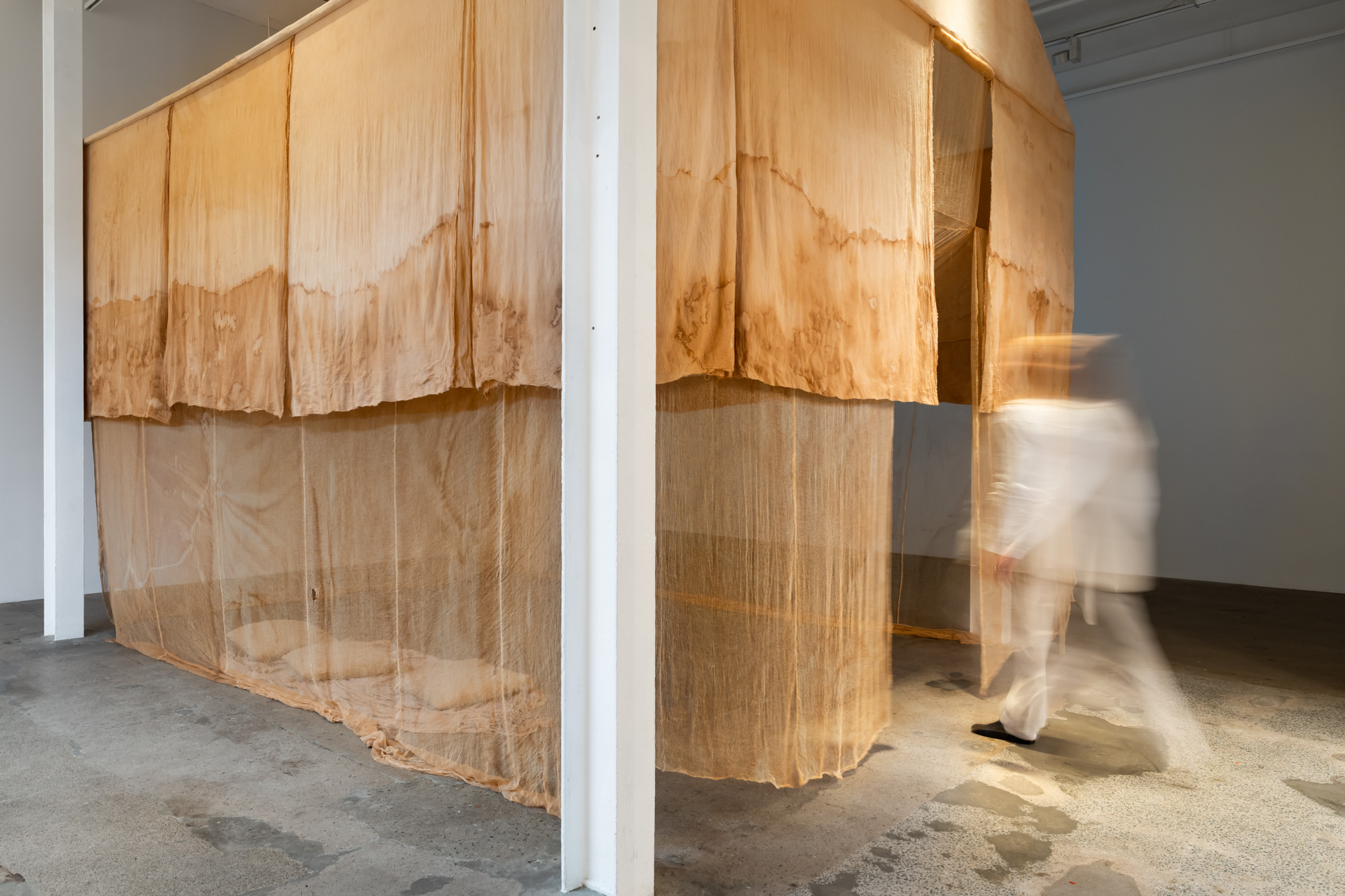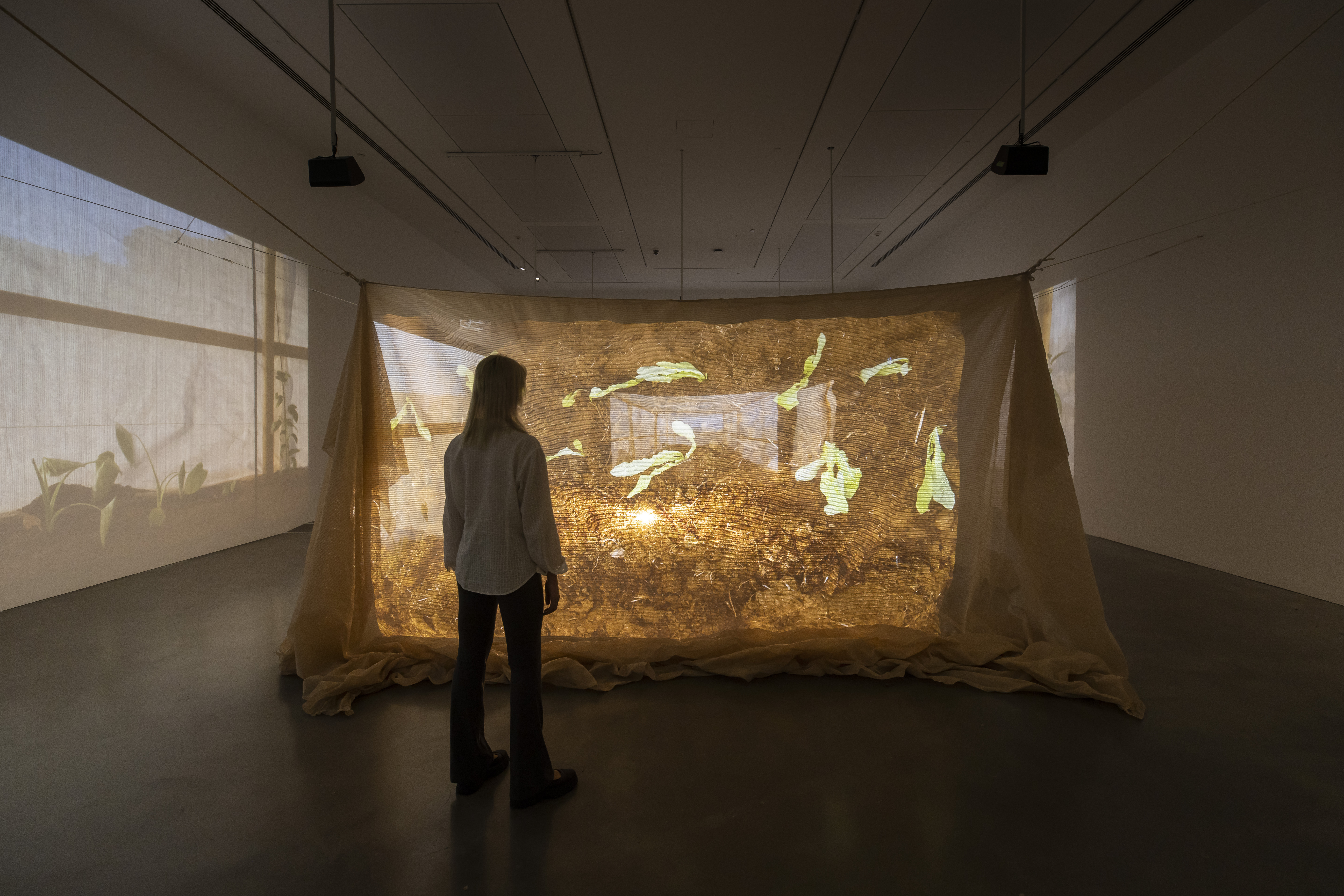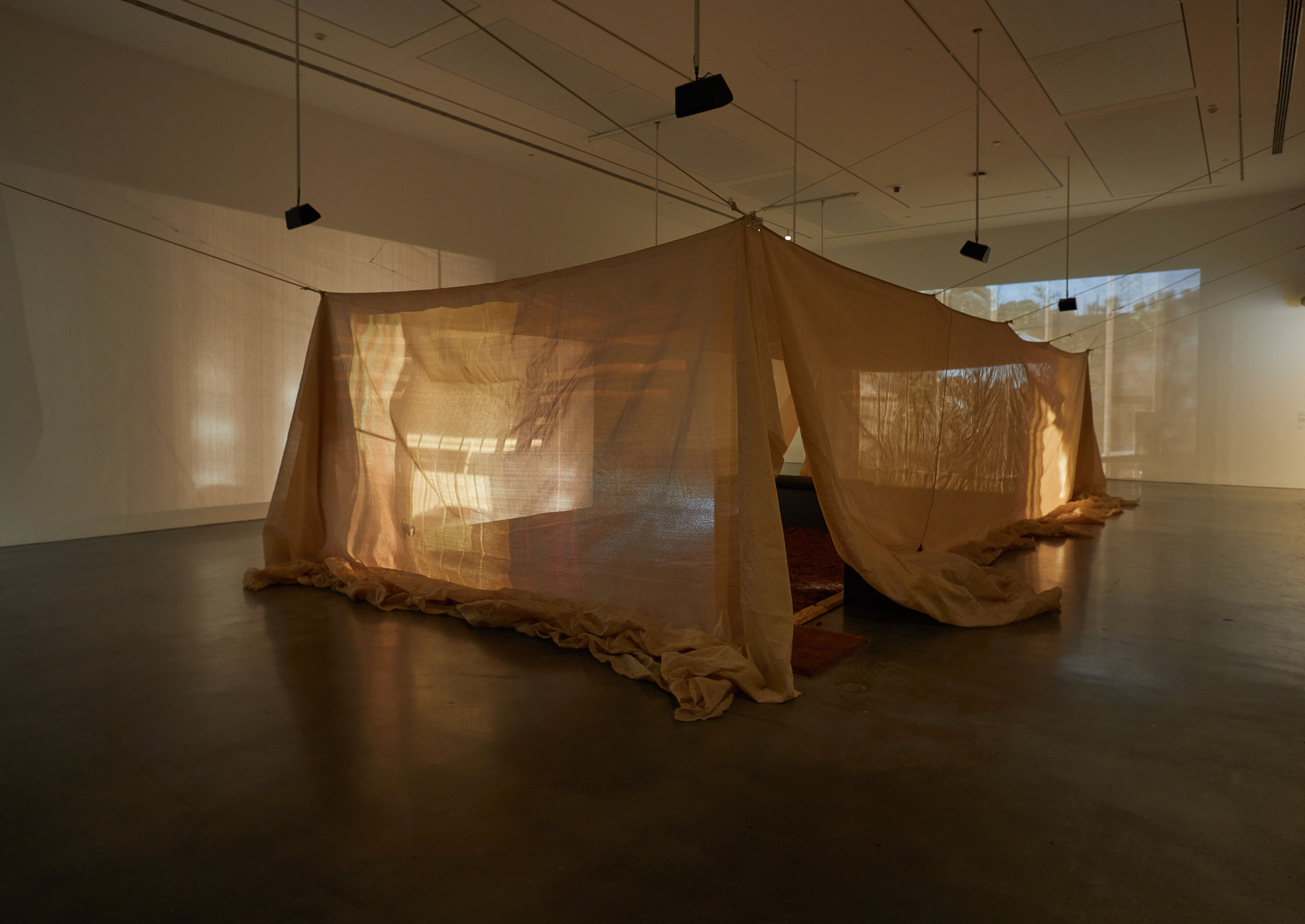
Disintegrate/Regenerate
(‘Memory House’ revisited) 2013/2025
Single-channel video, 12 mins, 35mm black and white photographs, sheer linen
Exhibited 19 Sept - 9 Nov at Bathurst Regional Art Gallery as part of ‘A Tear in the Fabric’ curated by Con Gerakaris at 4A Centre for Contemporary Asian Art.
Produced by Chris Luscri.
Produced on Kaurna Land.
“The process of disintegration is often gradual - a slow, fibrous crumbling into decay and dust. This physical and conceptual phenomenon is core to the of Cambodian-Australian filmmaker and artist Allison Chhorn as she examines the challenging and knotty relationship between place and memory. In Disintegrate/Regenerate (‘Memory House’ Revisited) (2025), Chhorn engages with her personal archive of still and moving images, reinterpreting the photographic series Memory House (2022) through the examination of material and visual degradation, housed in a ghostly, floating installation.
Built around a collection of 35mm black and white photographs taken between 2012 and 2013, Memory House documents the artist’s life and experience working on her family’s market garden on the outskirts of Adelaide. The series served as a study for Chhorn’s doc-fiction film The Plastic House (2019), a haunting piece about grief and the passage of time anchored to memories tied to location.
For this exhibition, the artist coalesces the diverse strands of her practice into a new installation exploring the relationship between reproductive disintegration and recollective memory.
As time passes and people change, the clarity of a memory obscures into evocative symbols, analogous to Chhorn’s material treatment of transposing film photography into a digital medium and again back into a new object through projection. With Disintegrate/Regenerate (‘Memory House’ Revisited) Chhorn poses a subtle provocation: With every reproduction, as the image disintegrates, does it also generate something new?”
- Con Gerakaris







Reflections in the Water (2025)
Single-channel video, 4-channel audio, 15min loop, Tea dyed muslin
Exhibited at Outer Space, Magandjin (Brisbane), 8 August - 6 September, 2025
Reflections in the Water explores the intergenerational process of remembering through fragments of recreated archival material depicting the Cambodian countryside along the Mekong River. The immersive installation becomes a water sanctuary, highlighting the equally healing and destructive nature of this essential element in the tropical climate of Cambodia.
Through recreated fragments of archival material, Chhorn invites viewers into an ephemeral meditation on memory, loss, and cultural continuity. In her hauntingly poetic reimagining, the ghost of her great-grandparents' Cambodian riverside house, now vanished due to the Mekong’s relentless erosion, becomes a vessel for reflecting on lives once lived.
Using docu-fictional techniques and Super 8-style footage, she stitches together vignettes of rural existence, rice planting, coconut cutting, communal cooking, each scene vivid yet incomplete, like memory itself. A floating house, crafted from tea-stained muslin, evokes both the murky floodwaters and the fragility of tradition. The duality of water in the tropical climate of Cambodia, essential for everyday living but equally destructive with flash flooding, speaks to the value of traditional living, the potential of a lost culture and the importance of intergenerational memory.
- O.S.
Exhibition text: Over the river, from a few lifetimes away by Nikki Lam
Producer: Chris Luscri
Additional Super 8 Cinematography & Hand Development: Bryce Kraehenbuehl
Sound Design & Mix: Josh Peters
Studio Assistant: Lucinda Corin
Seamstress: Isobel Davies
Thank you family and friends in Cambodia, Lyno Vuth, Nicholas Godfrey, Carmela Luscri, Anastasia Comelli and Pantelis Georgiadas
Photography: Outer Space Gallery Exhibition View. Photographed by Louis Lim. Courtesy of Outer Space.
Supported by Create SA and Nexus Arts





Skin Shade Night Day (2022)
Porter Street Commission at ACE Gallery, Adelaide, AustraliaSupported by the Government of South Australia (Arts SA)
4-channel video and 12-channel sound installation with shade cloth, rope, fishing wire and coconut coir, 45 minutes
Curator: Patrice Sharkey
Producers: Chris Luscri, Anastasia Comelli
Sound mix & spatialisation: Josh Peters
Colourist: Niklas Malkin
Photography: installation view, The National 4: Australian Art Now, Museum of Contemporary Art Australia, Sydney, 2023, photograph: Jenni Carter, Anna Kučera
Video Documentation: Ben Golotta
Skin Shade Night Day explores the daily routine and rituals practised by the artist’s Cambodian-Australian family, which are reperformed and documented through a process of embodied empathy. Acts of service, such as gardening and cooking, play out as echoes from the past across a sound and image installation displayed in a shadehouse. Spectres, shadows and aural textures conjure up impressions of a place that remembers how its inhabitants once lived.
Artist Statement
The first shade house was built with a wooden structure, planted in the ground of a rental property my family moved into after many months of finding a place for the project. It served as a place for my parents to grow their own garden—something I felt like they needed after selling the farm we had lived in for 17 years. Living with them again was also an opportunity to immerse myself in their lifestyle, largely unchanged since migrating from Cambodia over 40 years ago, and a chance to embody their routine, often done by hand.
While weeding with a hoe, my mum told me how her brother injured himself with one during the Khmer Rouge — something I always think about now when I use the tool. Physically experiencing these things for myself was a way for me to understand what they endured. Through gardening, I came to understand what it was like to look after a living thing everyday, to put in the work for its well-being and to watch it grow, not unlike the effort of raising children.
Closing the windows and making sure the doors were locked were also part of the daily routine. Physical barriers such as screen doors, bars and mesh are both forms of protection and, at the same time, entrap the plants and figures within. The sense of security has always been a priority in my family ever since experiencing a time without it, especially during the Khmer Rouge and refugee camp in the late 70’s and early 80’s. These rituals from the past have endured for so long, shaping my parents’ way of living.
My parents have always been collecting hard rubbish and picking up things left on the street to reuse into something else. This project saw used furniture repurposed into garden beds, plant containers and wooden support for the shadehouse. I realised my parents’ way of creatively transforming the used goods they find available to them is not dissimilar to my process of reimagining the environment around me into a heightened reality.
The only human presence that appears is in the form of shadow figures. My grandma is partially blind and her mental state has been deteriorating — her reliance on sound and increasing paranoia has been channelled into the atmosphere of the work. Every passing shadow becomes a figure once recognised.
While the original shade house continues to be a living and working site, the final shade house evokes the rituals lived, mediated and transformed. It’s a place that conjures up the past where memories and fears echo through its haunted walls.